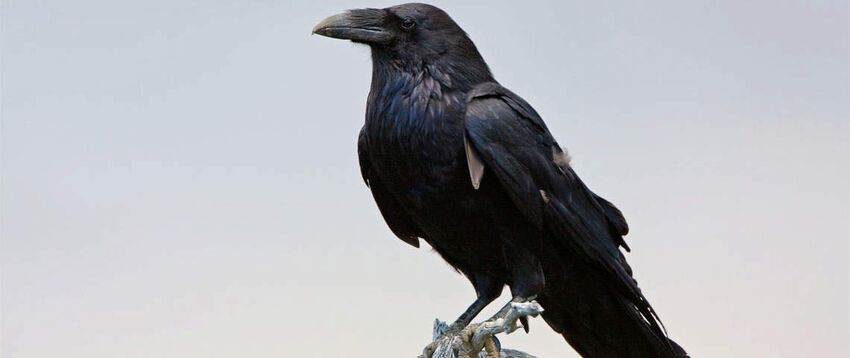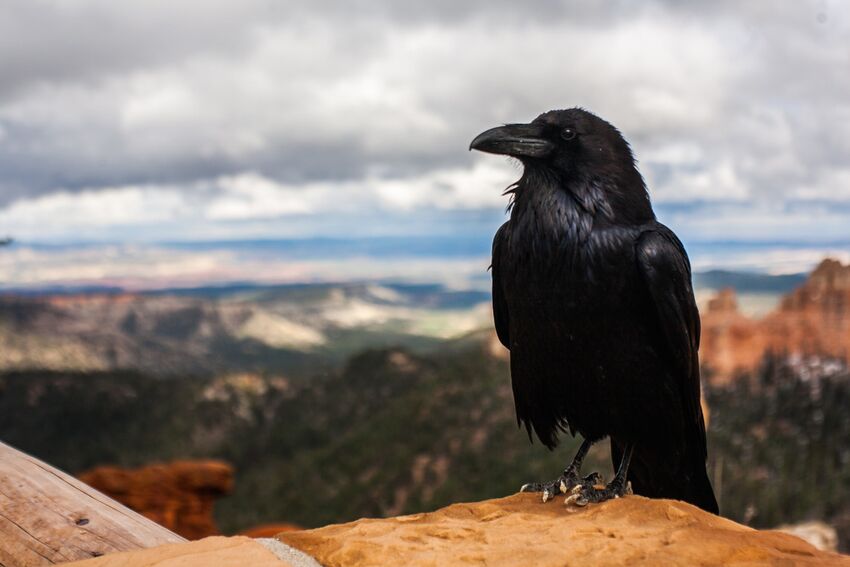Raven: Difference between revisions
(Created page with "=Why do we have a Raven in our Logo?= To answer that, let's look at Ravens in Mythology click on a Raven to return to the main CARC web site boarder | 50px link=Main_Page | left| 700px | center In Mythology, tradition and history, much as ham radio is a method of communications, Ravens have been seen as 'omens', 'signs' or 'messengers'. Sometimes of ill-will, bad-luck or of communications between of the gods. In a way, this parallels not on...") |
|||
| (7 intermediate revisions by the same user not shown) | |||
| Line 4: | Line 4: | ||
click on a Raven to return to the main CARC web site | click on a Raven to return to the main CARC web site | ||
[[File:Raven-header.jpg | boarder | | [[File:Raven-header.jpg | boarder | link=Main_Page | center | 850px ]] | ||
==Why a Raven?== | |||
In Mythology, tradition and history, much as ham radio is a method of communications, Ravens have been seen as 'omens', 'signs' or 'messengers'. Sometimes of ill-will, bad-luck or of communications between of the gods. In a way, this parallels not only our hobby, but our Public Service in times of need. | In Mythology, tradition and history, much as ham radio is a method of communications, Ravens have been seen as 'omens', 'signs' or 'messengers'. Sometimes of ill-will, bad-luck or of communications between of the gods. In a way, this parallels not only our hobby, but our Public Service in times of need. | ||
Amateur Radio operators, hams, are at their core: messengers. Often during times of disaster or failure of existing communications infrastructure, Amateur Radio is the only way to | Amateur Radio operators, hams, are at their core: messengers. Often during times of disaster or failure of existing communications infrastructure, Amateur Radio is the only way to communicate. | ||
And, at times, we can be a bit snooty, egotistical, about what we do, who we talk to. It's subtle and often overlooked, but having a Raven in our logo is also a reminder that even when useful, | And, at times, we can be a bit snooty, egotistical, about what we do, who we talk to. It's often subtle and often easily overlooked, but having a Raven in our logo is also a reminder that even when useful, "We ain't all that and a bag of nuts". | ||
==Mythology and folklore of the raven== | |||
A distinct black shape, tumbling in the updrafts of a misty mountain crag – a raven at play. The ‘gronking’ call of a raven is an evocative sound. The raven is the largest member of the crow family and one of the world’s most intelligent and playful birds. In the realm of myth, it is a bird of paradox, and something of a dark clown. | A distinct black shape, tumbling in the updrafts of a misty mountain crag – a raven at play. The ‘gronking’ call of a raven is an evocative sound. The raven is the largest member of the crow family and one of the world’s most intelligent and playful birds. In the realm of myth, it is a bird of paradox, and something of a dark clown. | ||
| Line 40: | Line 41: | ||
The indigenous people of America’s Pacific Northwest have a strong relationship with the this bird. Raven features in a number of creation stories and can be both trickster and hero. He also appears frequently in the distinctive artwork of these people. | The indigenous people of America’s Pacific Northwest have a strong relationship with the this bird. Raven features in a number of creation stories and can be both trickster and hero. He also appears frequently in the distinctive artwork of these people. | ||
Today | Today ravens are often associated with the wilds, but this is really because they have just been driven out of other areas. | ||
There is a lot of raven folklore | There is a lot of raven folklore. While some of this is somewhat sinister, the more we get to know this playful and intelligent bird, the more respect we might realize it deserves. | ||
[[File:Raven-2.jpg | link=Main_Page | center | 850px]] | |||
[ | ==Sources and further reading:== | ||
[https://www.allaboutbirds.org/guide/Common_Raven/overview Cornell Labs, Common Raven Overview] (Accessed 16 October 2024) | |||
Anon, Gantz, J. (translator).(1976). The Mabinogion. Penguin: London. | |||
Buczacki, S. (2002). Fauna Britannica. Hamlyn: London | |||
Heinrich, B. (2006). Mind of the Raven: Investigations and Adventures with Wolf-birds. Harper: New York. | |||
Holden, P. %26 Cleeves, T. (2014). RSPB Handbook of British Birds. Bloomsbury: London. | |||
Matthews, J. %26 Matthews, C. (1995). British and Irish Mythology. Diamond Books: London. | |||
Sturluson, S. (2006). The Prose Edda – Norse Mythology. Penguin: London. | |||
[https://scotlandsnature.blog/2014/03/31/the-raven/ The Raven ] on the Scotland Nature blog (Accessed 19th June 2020) | |||
[https://en.wikipedia.org/wiki/Raven_Tales Raven Tales] (Accessed 19th June 2020) | |||
Latest revision as of 05:54, 17 October 2024
Why do we have a Raven in our Logo?
To answer that, let's look at Ravens in Mythology
click on a Raven to return to the main CARC web site
Why a Raven?
In Mythology, tradition and history, much as ham radio is a method of communications, Ravens have been seen as 'omens', 'signs' or 'messengers'. Sometimes of ill-will, bad-luck or of communications between of the gods. In a way, this parallels not only our hobby, but our Public Service in times of need.
Amateur Radio operators, hams, are at their core: messengers. Often during times of disaster or failure of existing communications infrastructure, Amateur Radio is the only way to communicate.
And, at times, we can be a bit snooty, egotistical, about what we do, who we talk to. It's often subtle and often easily overlooked, but having a Raven in our logo is also a reminder that even when useful, "We ain't all that and a bag of nuts".
Mythology and folklore of the raven
A distinct black shape, tumbling in the updrafts of a misty mountain crag – a raven at play. The ‘gronking’ call of a raven is an evocative sound. The raven is the largest member of the crow family and one of the world’s most intelligent and playful birds. In the realm of myth, it is a bird of paradox, and something of a dark clown.
It was seen at times as a guardian. Unfortunately it also had a reputation as a bird of ill-omen. Its harsh call and its presence at scenes of death made people look upon it with fear. The old collective noun for a group of ravens is an ‘unkindness’. It’s a shame how humans have projected their own fears onto this fascinating and beautiful bird. The raven after all is just out there surviving and doing its thing.
The Gaelic word for raven is fitheach. A number of Scottish place names contain the words ‘an Fhithich or ‘nam Fitheach’, meaning ‘of the ravens’. An old Scottish name for the raven (and crows generally) is corbie, a word that can be traced back to the Latin corvus.
This large crow appears again and again in Celtic lore. In Welsh mythology, the god Bran the Blessed is a guardian of Britain whose totem is a raven. Bran ordered for his own head to be cut off, after which it could still speak words of prophecy.
Legend has it that Bran’s head was buried beneath Tower Hill, at the Tower of London. The presence of ravens at the Tower is an echo of this legend.
Bran is Welsh and Irish for raven. Interestingly the word sometimes appears in Scottish place names. Strath Bran, in the north of Trees for Life’s target area translates Valley of the Raven, and ravens are still present there today. In popular culture we encounter the this bird in George R.R. Martin’s Game of Thrones when a three-eyed raven visits Bran Stark in his dreams.
Arthur, another legendary guardian of Britain, is also associated with ravens. In Cornwall it was believed that Arthur didn’t really die, but was magically transformed into this bird.
The Celts were no strangers to war and the presence of ravens on the battlefield would have been very familiar to them. The Irish goddess Morrighan had a number of different guises. In her aspect as goddess of war, warriors believed she was there on the battlefield in the form of a raven.
One Scottish legend tells of a hag called Cailleach. She took the form of a number of birds, including the raven, and feasted on men’s bodies.
Odin, the chief of the Norse gods, was accompanied by a pair of ravens. Hugin (thought) and Munin (memory) would fly far and wide to bring news to Odin. One of Odin’s names, Hrafnagud, means the ‘Raven God’.
In the Old Testament, the raven is the first bird Noah sent to look for land, and Elijah is described as being provided for by ravens. They are used as a symbol of God’s providence in both the New Testament and in Christian art.
Our hunter-gatherer ancestors would have observed the keen intelligence of this bird. Ravens have a symbiotic relationship with wolves. The birds follow wolves around and benefit from their kills. It is thought that wolves may also respond to raven calls, indicating where there is prey. There are even anecdotes from modern deer-stalkers who report that ravens will help them to locate deer. The birds know that they will receive the ‘gralloch’ or guts after the deer is killed.
The indigenous people of America’s Pacific Northwest have a strong relationship with the this bird. Raven features in a number of creation stories and can be both trickster and hero. He also appears frequently in the distinctive artwork of these people.
Today ravens are often associated with the wilds, but this is really because they have just been driven out of other areas.
There is a lot of raven folklore. While some of this is somewhat sinister, the more we get to know this playful and intelligent bird, the more respect we might realize it deserves.
Sources and further reading:
Cornell Labs, Common Raven Overview (Accessed 16 October 2024)
Anon, Gantz, J. (translator).(1976). The Mabinogion. Penguin: London.
Buczacki, S. (2002). Fauna Britannica. Hamlyn: London
Heinrich, B. (2006). Mind of the Raven: Investigations and Adventures with Wolf-birds. Harper: New York.
Holden, P. %26 Cleeves, T. (2014). RSPB Handbook of British Birds. Bloomsbury: London.
Matthews, J. %26 Matthews, C. (1995). British and Irish Mythology. Diamond Books: London.
Sturluson, S. (2006). The Prose Edda – Norse Mythology. Penguin: London.
The Raven on the Scotland Nature blog (Accessed 19th June 2020)
Raven Tales (Accessed 19th June 2020)

